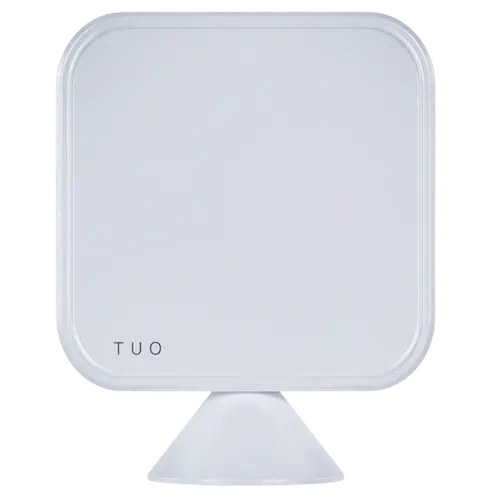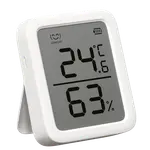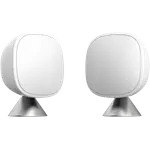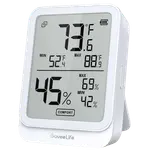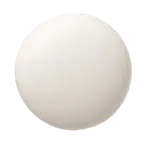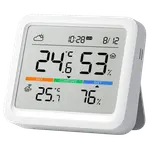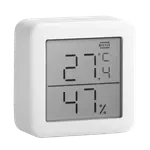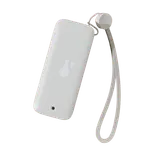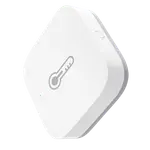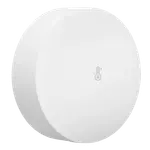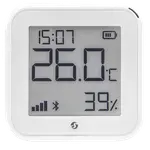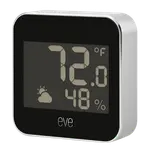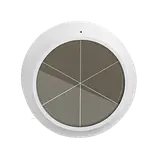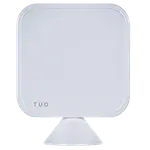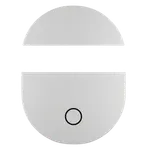Summary
Size & Materials: 40 x 40 x 10.2 mm
Connectivity: Bluetooth, Thread Protocol (Thread Border Router required)
Integrations: Google Home, Apple HomeKit, Samsung SmartThings, Home Assistant, Matter
Sensors: Temperature, Humidity, Atmospheric Pressure, Air Quality
Price History
Loading price history...
| Brand | Arre |
|---|---|
| Headquarters | |
| Website | https://arrehome.com |
| @arrehomellc |
Size & Materials
Devices are typically rated using the Ingress Protection (IP) scale, which indicates the level of protection against dust, solid particles, and moisture.
An IP rating (Ingress Protection rating) is a standardized way to describe how well a device is protected against solids (like dust) and liquids (like water). The rating consists of two digits:
- The first digit represents protection against solid particles (e.g., dust).
- The second digit represents protection against liquids (e.g., water).
First Digit (Protection Against Solids):
- IP0X: No protection against solid objects.
- IP1X: Protection against solid objects larger than 50 mm (e.g., accidental touch by hand).
- IP2X: Protection against objects larger than 12.5 mm (e.g., fingers).
- IP3X: Protection against objects larger than 2.5 mm (e.g., tools or thick wires).
- IP4X: Protection against objects larger than 1 mm (e.g., thin wires or small tools).
- IP5X: Dust-protected. Limited ingress of dust is allowed, but it won't interfere with operation.
- IP6X: Dust-tight. Complete protection against dust, ensuring no ingress of particles.
Second Digit (Protection Against Liquids)
- IPX0: No protection against water.
- IPX1: Protection against vertically falling water droplets (e.g., light rain).
- IPX2: Protection against vertically dripping water when tilted up to 15°.
- IPX3: Protection against water sprayed at an angle of up to 60° (e.g., light splashing).
- IPX4: Protection against water splashes from any direction.
- IPX5: Protection against water jets from any direction (e.g., a garden hose).
- IPX6: Protection against powerful water jets (e.g., heavy rain or washing with a hose).
- IPX7: Protection against temporary immersion in water up to 1 meter deep for up to 30 minutes.
- IPX8: Protection against continuous immersion in water beyond 1 meter.
NO
Length x Width x Height
- Length: the longest side of the device
- Width: the shorter side of the device
- Height: the vertical dimension of the device
40 x 40 x 10.2 mm
The physical weight of the device, typically measured in grams (g) or ounces (oz).
Weight can be important for installation considerations, especially for wall-mounted or battery-powered devices.
?
Power
Battery-powered sensors typically use standard batteries like AA, AAA, or button-cell batteries (CR2032, CR123A), which are easy to replace and widely available.
CR2032
Sensors that connect via Wi-Fi tend to consume more power due to the constant need to maintain a connection with the network, meaning more frequent battery replacements.
Zigbee, Z-Wave, and Thread Sensors are designed for low-power devices, allowing sensors to last much longer on battery power, often up to 3-5 years before needing a battery change.
Bluetooth Low Energy (BLE) sensors have moderate power consumption, offering a reasonable battery life depending on usage.
1 year
Connectivity
Range: The 2.4 GHz band offers a longer range, meaning it can cover larger areas and penetrate solid objects like walls more effectively than 5 GHz.
Speed: Generally, 2.4 GHz provides slower speeds compared to 5 GHz due to a lower maximum data rate.
Interference: More prone to interference since many other devices (like cordless phones, microwaves, and Bluetooth devices) operate on the 2.4 GHz frequency, leading to potential congestion and slower network performance.
NO
Range: Offers a shorter range compared to 2.4 GHz and may have difficulty penetrating walls and other obstacles.
Speed: Typically provides faster speeds and higher data rates due to more available bandwidth.
Interference: Less prone to interference as fewer devices operate on this frequency, leading to a more stable connection.
NO
Bluetooth is a wireless communication technology used for exchanging data over short distances.
Bluetooth enables devices to communicate wirelessly within a short range, typically up to 10 meters (about 33 feet) for most consumer devices.
YES
Zigbee is a wireless communication protocol designed for low-power, short-range applications, commonly used in smart home devices, industrial automation, and other areas requiring reliable, low-data rate communication. It features low power consumption, making it ideal for battery-operated devices, and supports short-range communication, typically up to 100 meters. Zigbee employs mesh networking, allowing devices to relay data through each other to extend range and improve reliability. It supports data rates up to 250 kbps, suitable for small data packets, and ensures interoperability among devices from different manufacturers if they conform to Zigbee standards. Security is robust, with AES-128 encryption for data protection.
Z-Wave is known for its low power consumption, making it ideal for battery-powered devices. It supports a mesh networking topology, allowing devices to communicate with each other directly or through intermediary nodes, thus extending the overall network range and enhancing reliability. The protocol supports data rates of up to 100 kbps, suitable for transmitting control commands and sensor data.
NO
Zigbee is a wireless communication protocol designed for low-power, short-range applications, commonly used in smart home devices, industrial automation, and other areas requiring reliable, low-data rate communication. It features low power consumption, making it ideal for battery-operated devices, and supports short-range communication, typically up to 100 meters. Zigbee employs mesh networking, allowing devices to relay data through each other to extend range and improve reliability. It supports data rates up to 250 kbps, suitable for small data packets, and ensures interoperability among devices from different manufacturers if they conform to Zigbee standards. Security is robust, with AES-128 encryption for data protection.
Zigbee devices need a Zigbee-compatible hub to connect and communicate with other devices in your smart home setup.
NO
Thread is a wireless communication protocol designed specifically for Internet of Things (IoT) devices, providing secure, reliable, and scalable networking. Unlike some other protocols, Thread is IP-based, which means it can seamlessly integrate with existing internet infrastructure. It operates in the 2.4 GHz frequency band and uses mesh networking to enhance reliability and extend range by allowing devices to relay data through each other.
Thread is optimized for low power consumption, making it suitable for battery-operated devices. It supports low-latency communication, which is crucial for real-time applications like home automation and security systems. The protocol ensures high security with AES-128 encryption and end-to-end security at the network layer. Thread also supports over-the-air updates, ensuring devices can stay up to date with the latest features and security patches.
Thread-enabled devices require a Thread Border Router (such as certain smart home hubs or routers) to connect to your home network and other Thread devices.
Thread Border Router required
Additional connectivity options not covered by the standard protocols.
This may include proprietary wireless protocols, infrared, or other specialized communication methods.
NO
Display
Indicates whether the device has a built-in display screen.
A screen can show real-time information, settings, and status without needing to check a mobile app.
NO
The type of display technology used, such as LCD, OLED, E-ink, or LED.
Different screen types offer varying levels of visibility, power consumption, and image quality.
-
Indicates whether the display can show colors or is limited to monochrome.
Color screens can display more detailed information and provide a better user experience.
-
Indicates whether the display responds to touch input for direct interaction.
Touch screens allow for easier navigation and control without needing physical buttons.
-
The diagonal measurement of the display screen, typically in inches.
Larger screens are easier to read from a distance but may consume more power.
-
The pixel dimensions of the display, indicating how sharp and detailed the screen output will be.
Higher resolution displays show clearer text and more detailed information.
-
Display of weather predictions and forecasts.
Weather forecast helps you plan daily activities and understand outdoor conditions.
-
Current time display functionality.
Time display provides convenient clock functionality in addition to environmental monitoring.
-
Current date display functionality.
Date display provides calendar reference along with environmental data.
-
Integrations
Google Home serves as a central hub for a variety of smart devices, including lights, thermostats, cameras, and speakers. It leverages Google Assistant for voice control, enabling users to manage their smart home with simple commands.
YES
Amazon Alexa is one of the most widely used smart home systems, known for its compatibility with a vast array of devices. Users can control everything from smart lights to appliances using voice commands through Echo devices.
NO
Apple HomeKit is designed for users in the Apple ecosystem, providing a seamless way to control compatible smart devices through iOS devices using the Home app or Siri. It emphasizes security and user privacy.
YES
SmartThings is a flexible platform that connects a wide range of devices from different brands, offering a unified interface for control. It supports various communication protocols, allowing for extensive device compatibility.
YES
Home Assistant is an open-source platform that allows for extensive customization and integration of a wide variety of smart devices. It supports a multitude of protocols and brands, making it ideal for tech-savvy users.
YES
IFTTT (If This Then That) is a web-based service that allows users to create simple automation sequences, known as applets, which enable different devices, services, and applications to work together seamlessly. It connects a wide range of products and services, facilitating interoperability and enhancing functionality.
NO
Matter is a unified, open-source connectivity protocol designed to standardize and simplify communication between smart home devices from different manufacturers. Developed by the Connectivity Standards Alliance (formerly the Zigbee Alliance), Matter aims to improve interoperability, security, and reliability across various smart home ecosystems.
Matter operates over existing networking technologies, including Ethernet, Wi-Fi, and Thread, providing flexibility in device connectivity. Its IP-based nature allows seamless integration with existing internet infrastructure and cloud services. Matter uses a mesh networking topology, particularly when operating over Thread, to enhance range and reliability by allowing devices to relay data through each other.
Security is a cornerstone of Matter, with end-to-end encryption and secure device onboarding processes ensuring robust protection for data and privacy. Matter also supports over-the-air updates, allowing devices to stay current with the latest features and security enhancements.
YES
Sensors
Measures ambient temperature in the surrounding environment.
Temperature monitoring helps maintain comfortable conditions and can trigger heating/cooling automations.
YES
Measures relative humidity levels in the air.
Humidity monitoring helps prevent mold growth and maintains optimal indoor air quality.
YES
Measures atmospheric pressure, also known as barometric pressure, in the surrounding environment.
Atmospheric pressure monitoring can help predict weather changes and may be useful for individuals sensitive to pressure variations.
YES
Monitoring of general air quality including particulates and pollutants.
Air quality monitoring helps maintain healthy indoor environments and can trigger ventilation systems.
YES
Detects whether a room or area is occupied, based on movement or other triggers.
Occupancy sensors are useful for energy-saving automations and security applications.
NO
Alerts
Notifications when temperature readings exceed or fall below preset thresholds.
Temperature alerts can help prevent damage to sensitive items and ensure comfortable living conditions.
?
Notifications when humidity levels become too high or too low for optimal comfort and health.
Proper humidity levels (30-50%) prevent mold growth and maintain respiratory comfort.
?
Notifications when air quality measurements indicate unhealthy conditions.
Air quality alerts help you take action to improve indoor air, such as increasing ventilation or running air purifiers.
?
Notifications when the device's battery level becomes critically low.
Battery alerts ensure you can replace or recharge batteries before the device stops functioning.
?
Features
The ability to create automated actions based on sensor readings or schedules.
Automations can trigger other smart devices, send notifications, or adjust settings without manual intervention.
?
The ability to track and store historical data over time.
Historical records help you identify patterns, track trends, and review past events for security or optimization purposes.
?
Compare smart temperature and humidity sensors by accuracy, connectivity, display, battery life, alerts, integrations, automations, and supported protocols.
![Nest Temperature Sensor]() Google
GoogleNest Temperature Sensor
![SwitchBot Meter Plus]() SwitchBot
SwitchBotMeter Plus
![Ecobee SmartSensor]() Ecobee
EcobeeSmartSensor
![Govee Life Hygrometer Thermometer H5104]() Govee Life
Govee LifeHygrometer Thermometer H5104
![Nest Temperature Sensor (2nd gen)]() Google
GoogleNest Temperature Sensor (2nd gen)
![X-Sense Smart WiFi Indoor Thermometer]() X-Sense
X-SenseSmart WiFi Indoor Thermometer
![SwitchBot Meter Pro]() SwitchBot
SwitchBotMeter Pro
![SwitchBot Meter]() SwitchBot
SwitchBotMeter
![SwitchBot Indoor/Outdoor Thermo-Hygrometer]() SwitchBot
SwitchBotIndoor/Outdoor Thermo-Hygrometer
![Aqara Temperature and Humidity Sensor]() Aqara
AqaraTemperature and Humidity Sensor
![Sonoff LCD Smart Temperature Humidity Sensor]() Sonoff
SonoffLCD Smart Temperature Humidity Sensor
![Sonoff SNZB-02P Temperature & Humidity Sensor]() Sonoff
SonoffSNZB-02P Temperature & Humidity Sensor
![Shelly H&T Gen3]() Shelly
ShellyH&T Gen3
![Eve Weather]() Eve
EveWeather
![Sonoff SNZB-02 Temperature & Humidity Sensor]() Sonoff
SonoffSNZB-02 Temperature & Humidity Sensor
![Meross Smart Temperature and Humidity Sensor]() Meross
MerossSmart Temperature and Humidity Sensor
![Arre Temperature Sensor]() Arre
ArreTemperature Sensor
![Eve Weather]() EveWeather
EveWeather![SwitchBot Meter Plus]() SwitchBotMeter Plus
SwitchBotMeter Plus![SwitchBot Meter Pro]() SwitchBotMeter Pro
SwitchBotMeter Pro![SwitchBot Meter]() SwitchBotMeter
SwitchBotMeter![SwitchBot Indoor/Outdoor Thermo-Hygrometer]() SwitchBotIndoor/Outdoor Thermo-Hygrometer
SwitchBotIndoor/Outdoor Thermo-Hygrometer![Shelly H&T Gen3]() ShellyH&T Gen3
ShellyH&T Gen3![Aqara Temperature and Humidity Sensor]() AqaraTemperature and Humidity Sensor
AqaraTemperature and Humidity Sensor![Meross Smart Temperature and Humidity Sensor]() MerossSmart Temperature and Humidity Sensor
MerossSmart Temperature and Humidity Sensor![Ecobee SmartSensor]() EcobeeSmartSensor
EcobeeSmartSensor![Govee Life Hygrometer Thermometer H5104]() Govee LifeHygrometer Thermometer H5104
Govee LifeHygrometer Thermometer H5104![Sonoff LCD Smart Temperature Humidity Sensor]() SonoffLCD Smart Temperature Humidity Sensor
SonoffLCD Smart Temperature Humidity Sensor![Sonoff SNZB-02P Temperature & Humidity Sensor]() SonoffSNZB-02P Temperature & Humidity Sensor
SonoffSNZB-02P Temperature & Humidity Sensor![Sonoff SNZB-02 Temperature & Humidity Sensor]() SonoffSNZB-02 Temperature & Humidity Sensor
SonoffSNZB-02 Temperature & Humidity Sensor![Nest Temperature Sensor]() GoogleNest Temperature Sensor
GoogleNest Temperature Sensor![Nest Temperature Sensor (2nd gen)]() GoogleNest Temperature Sensor (2nd gen)
GoogleNest Temperature Sensor (2nd gen)![X-Sense Smart WiFi Indoor Thermometer]() X-SenseSmart WiFi Indoor Thermometer
X-SenseSmart WiFi Indoor Thermometer

